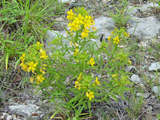Native Plants

Q. Who is Mr. Smarty Plants?
A: There are those who suspect Wildflower Center volunteers are the culpable and capable culprits. Yet, others think staff members play some, albeit small, role. You can torture us with your plant questions, but we will never reveal the Green Guru's secret identity.
Did you know you can access the Native Plant Information Network with your web-enabled smartphone?
Ask Mr. Smarty Plants is a free service provided by the staff and volunteers at the Lady Bird Johnson Wildflower Center.

rate this answer
Monday - February 15, 2010
From: New Braunfels, TX
Region: Southwest
Topic: Shrubs
Title: Native shrubs to plant after Ashe Juniper removal
Answered by: Nina Hawkins
QUESTION:
I live on 7 acres of beautiful Texas Hill Country land just north of New Braunfels. Live oak, Cedar elm, and Ashe juniper dominate the landscape. I have cleared some of the Ashe juniper and would like to plant several native shrubs throughout the seven acres. I have already had some success growing Texas Mountain Laurel and Mexican Buckeye from seed. I would appreciate any suggestions you might have for additional native shrubs which would need to be somewhat deer resistant. Thank you.ANSWER:
The following shrubs would be right at home on your Hill Country acreage and are purported to be moderately to highly deer resistant.
Leucophyllum frutescens (Texas barometer bush)
Mahonia trifoliolata (agarita)
Senna lindheimeriana (velvet leaf senna)
Senna roemeriana (twoleaf senna)
Mimosa borealis (fragrant mimosa)
Young plants are especially attractive forage for deer, so you may still want to protect them when more appealing food supplies are low. You'll find many more suggestions on our Recommended Species page for Central Texas (just narrow your search down to "Shrubs" on the "General Appearance" dropdown menu), but this list should get you off to a good start!
More Shrubs Questions
Fast-growing drought-resistant hedge for California
September 03, 2013 - We're looking for a fast growing, drought resistant shrub that will grow in clay soil and can be used for a hedge around our property.
view the full question and answer
Flowering evergreen plant for ceramic pot
April 02, 2013 - I have a deep ceramic pot that I would like to put in a flowering evergreen plant or bush. It is on the deck facing west but with north and south exposure and afternoon sun.
view the full question and answer
Problems with non-native Japanese privet from Glendale AZ
December 26, 2012 - We have Japanese privet shrub and they seem to be suffering from a disease, need help.
view the full question and answer
Maine Coastal Shrub for Choral Composition
January 30, 2016 - I'm a choral composer writing a piece of music about Maine. What kind of shrubby things hang on to the rocky bluffs, right by the sea? I'm an avid native plant gardener, but I know my own Massachu...
view the full question and answer
Removal of honeysuckle bushes from Coaldale Alberta Canada
July 30, 2010 - I have 2 honeysuckle bushes that I want to get rid of. I am wondering if Honeysuckle bushes have very deep roots (are they hard to dig out?) I am 70 years old and didn't know if I'd be able to dig ...
view the full question and answer
| Support the Wildflower Center by Donating Online or Becoming a Member today. |

